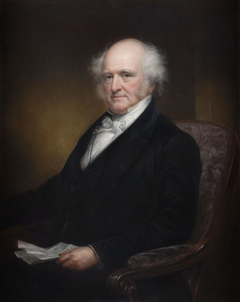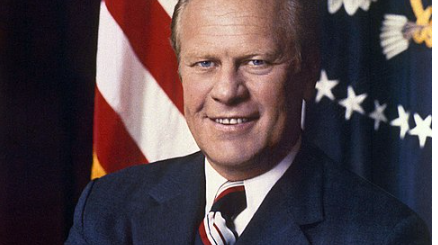Important Facts About Martin Van Buren’s Life and Achievements

The 8th President of the United States, Martin Van Buren | Portrait by Daniel Huntington
Born on December 5, 1782, Martin Van Buren came from humble beginnings in the region of Kinderhook, New York State, to become the eighth president of the United States. Throughout the course of his life, he committed himself to lay the foundation for the current American, two-party political system. However, with only a single term in the White House, Van Buren hardly gets any honorable mention when it comes to greatest of American presidents. Plagued by the economic depression of 1837, there was certainly very little room for him to leave a long-lasting mark on the country.
Regardless, he did make sure that the internal political structure of his party was organized in a disciplined and professional manner. At his peak, Martin Van Buren was one of the most influential politicians in the state of New York. He was an expert politician, someone who knew exactly how to form and manage alliances. The following are some important facts about Martin Van Buren’s life and achievements during his presidency:
- All in all, Van Buren had six siblings – four siblings and three half-siblings.
- The public house/bar that was run by his father was often graced by the presence of notable politicians such as Alexander Hamilton and Aaron Burr.
- Growing up in the town of Kinderhook in New York, his friends often called him the “Little Mat”.
- In addition to his numerous nicknames, Van Buren was called “Old Kinderhook” or simply “Ok”.
- Up to this day, Van Buren holds the record of being one of two men in America’s history (the other being Thomas Jefferson) to hold three top political positions in a continuous order: Secretary of State from 1829 to 1831; Vice President from 1833 to 1837; and then the President of the United States of America from 1837 to 1841.
- After his wife passed away in 1819 due to tuberculosis, Martin Van Buren opted to stay unmarried for the rest of his life. While in the White House, the duty of the first lady fell on the shoulders of his daughter-in-law, Angelica Singleton Van Buren.
- Van Buren was a master political organizer. He is famed to have started the Albany Regency, a group of well-connected politicians that helped run his party in a very efficient manner. The group also opposed New York governor De Witt Clinton’s manner in steering the affairs of the state. They regarded De Witt as very autocratic in nature, someone who placed his allies in key state positions, often to the detriment of New Yorkers. Out of this opposition came the Albany Regency.
- Due to his relatively short height, he was sometimes referred to as “the Little Magician”. His other nicknames were “the red fox” and “Martin Van Ruin”. The first alias was obtained due to his cunning and swift way of conducting business. With regards to the “Martin Van Ruin”, his opponents made it in reference to the alleged role he played during the stock market crash of 1837.
- His inability to extricate himself from the policies and legislative acts of his predecessor, Van Buren helped to perpetuate the “spoils system”. The system allowed the government to reward party loyalists and supporters with key government positions after an election win.
- Andrew Jackson strongly admired Van Buren for his ability to get influential politicians to support his policies across the political divide. He was seen as the linking pin between voters in the South and the North.
- Right from the onset, the Jackson-Van Buren alliance was one underpinned by similar ideas and belief set. The two men worked hand in hand to cripple the Second Bank of the United States. They believed that the bank was the cause of many ills that the American people (the common man) faced.
- Coupled with Jackson’s eight years in office, Van Buren’s presidency could do little to avert the 1837 economic depression and the bitter years of the “trail of Tears”. The “trail of tears” was an absolutely horrific period that Native Americans endured due to the federal government’s forced ejection of them from their lands. Owing to actions of the federal government between 1838 and 1839, a staggering 4,000 Native Americans in the Cherokee tribes died from starvation, disease, and physical exhaustion.
- Another great attribute of Van Buren was his ability to bring warring factions in his party together, making the Democratic Party a real force to be reckoned with in American politics. Had it not been his tireless efforts put into the structure of the party, James Polk would not have had the tools to go on become president.
- The annexation of Texas and Oregon was the major issue that ended up costing Van Buren to lose the Democratic Party nomination in 1844. In the lead up to the 1844 presidential election, his opponent, James K. Polk, ran on the promise of annexing both Texas and Oregon. However, Van Buren begged to differ otherwise.
- Ever since the issue flared up during his presidency, Van Buren had always maintained that the U.S. Constitution provided no means for the U.S. to annex a sovereign nation. He also feared that if care was not taken, the annexation of Texas could result in an all-out war with Mexico.
- During his presidency, Richard M. Johnson served as his vice president.
- Fearing that admission of Texas, a slave-holding state, into Union could spell doom for the country, Van Buren categorically refused to annex Texas. The country was at already divided on the issue of slavery. Why add more fuel to the fire? He thought to himself.
- His smooth handling of the 1839 altercations during the Maine-New Brunswick border dispute was a catalyst to the Webster-Ashburton Treaty signed in 1842.
- Van Buren believed that the 53 slaves aboard the Spanish Amistad actually mutinied against their captains. He held the view that they were guilty and as such be returned to the Spanish government to face punishment. However, the slaves were eventually exonerated of the mutiny charges. This was primarily due to a solid defense they received from John Quincy Adams.
- Another very important fact about Martin Van Buren is that he set the maximum working hour for employees/federal employees at 10 hours a day.
- So great was the reputation of his predecessor that on March 4, 1837, when Martin Van Buren was sworn into office, a large horde of people graced the occasion primarily to say farewell to outgoing president, Andrew Jackson. The main sight of attraction was not Van Buren, but rather, it was the Battle of New Orleans (1815) war hero and major general, Andrew Jackson. Van Buren himself acknowledged the crowd’s excitement over catching a glimpse of Andrew Jackson.
- Considering the fact that he died on July 24, 1862, Martin Van Buren witnessed the dawning of the American Civil War in 1861.
- In addition to the highest office in the land, the major elected offices that he held over the years were: New York State Senator, from 1812 to 1820; New York Attorney-General, from 1815 to 1819; Governor of New York for just 3 months in 1829; U.S. Secretary of State, from 1829 to 1831; Ambassador to England, 1831; and Vice President, from 1833 to 1837.
Read More about Martin Van Buren, his life story and the difficulties he encountered during his time in office.



























